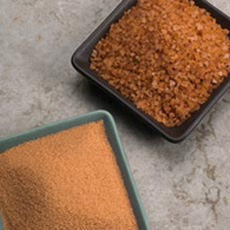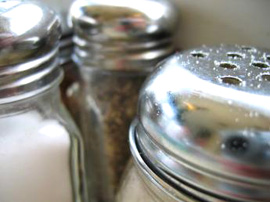

Alaea Sea Salt is a traditional Hawaiian table salt used to season and preserve. Alaea is a natural mineral volcanic baked red clay, added to enrich the salt with iron oxide. Photo courtesy of Saltworks.us, a wonderful resource for many types of sea salt. See more salts in our Salt Glossary.
KAREN HOCHMAN is Editorial Director of THE NIBBLE.
|
June 2006
Updated November 2008 |
 |
Product Reviews / Main Nibbles / Seasonings
A Brief History of Salt
From Prehistory To Gourmet Sea Salts
CAPSULE REPORT: Looking for information about salt? You’ll learn about it here. The world history of salt is fascinating: What we take for granted in the ubiquitous salt shaker has been as precious as gold to people throughout the ages. It engendered wars and caused Marie Antoinette to lose her head.
Salt Origins: A Brief History Of Salt
What seems like such an inexpensive commodity has been used since pre-historic times as currency, medicine and an enhancer and preservative of food. In cooking, salt enlivens the taste of food, intensifying and balancing flavors. Salt has long been used in pickling and in curing vegetables, meats, fish and cheese. Salt has played a prominent role in religious ritual in many cultures, symbolizing purity. There are more than 30 references to salt in the Bible, from expressions like “salt of the earth” to Lot’s wife (although given what we now know to be the expense of salt in earlier times, she was turned into a pillar of extreme value). Salt is also an essential element for the  living: life itself would be impossible without it, since the human body requires salt in order to function properly. (For instance, that thousands of Napoleon’s troops died during his retreat from Moscow is attributed to their wounds not healing due to a lack of salt.) And salt is also used in some 14,000 commercial applications, from manufacturing pulp and paper to setting dyes in textiles and fabric, producing soaps and detergents to making icy roads safe. living: life itself would be impossible without it, since the human body requires salt in order to function properly. (For instance, that thousands of Napoleon’s troops died during his retreat from Moscow is attributed to their wounds not healing due to a lack of salt.) And salt is also used in some 14,000 commercial applications, from manufacturing pulp and paper to setting dyes in textiles and fabric, producing soaps and detergents to making icy roads safe.
- Salt was in general use long before recorded time. Its use in pickling predates the 5000-year written Chinese history. Around 2,700 B.C.E. in China, the earliest known treatise on pharmacology, the Peng-Tzao-Kan-Mu, devoted a major portion to a discussion of more than 40 kinds of salt. Profits from the sale of salt financed the Great Wall. More “recently,” in 1450 B.C.E., Egyptian art depicts salt-making (ancient Egyptians also used salt for mummification). By 200 B.C.E., people discovered that adding salt to food kept it from spoiling.
- The ancient Chinese used salt to make a fermented fish sauce. So did the ancient Romans: garum was the Roman equivalent of catsup, a condiment that was used on nearly everything. Royal purple dye was discovered by accident when a garum-maker tried to cook a particular variety of shellfish in the sauce. Reacting with the salt, the shellfish exuded the reddish-purple dye.
- Since currencies in different countries have always differed, salt was an international currency: it was an important trading commodity carried by explorers. Greece, involved in a far-reaching slave trade, exchanged salt for slaves, giving rise to the expression, “not worth his salt.”
- Special salt rations given to Roman soldiers along with their wages were known as salarium argentum, the term from which our word “salary” is derived. As an essential ingredient in food, the Latin word “sal” found its way into salsa and salami.
Continue To Page 2: The Middle Ages
Go To The Article Index Above
Lifestyle Direct, Inc. All rights reserved. Images are the copyright of their respective owners.

|





 living: life itself would be impossible without it, since the human body requires salt in order to function properly. (For instance, that thousands of Napoleon’s troops died during his retreat from Moscow is attributed to their wounds not healing due to a lack of salt.) And salt is also used in some 14,000 commercial applications, from manufacturing pulp and paper to setting dyes in textiles and fabric, producing soaps and detergents to making icy roads safe.
living: life itself would be impossible without it, since the human body requires salt in order to function properly. (For instance, that thousands of Napoleon’s troops died during his retreat from Moscow is attributed to their wounds not healing due to a lack of salt.) And salt is also used in some 14,000 commercial applications, from manufacturing pulp and paper to setting dyes in textiles and fabric, producing soaps and detergents to making icy roads safe.